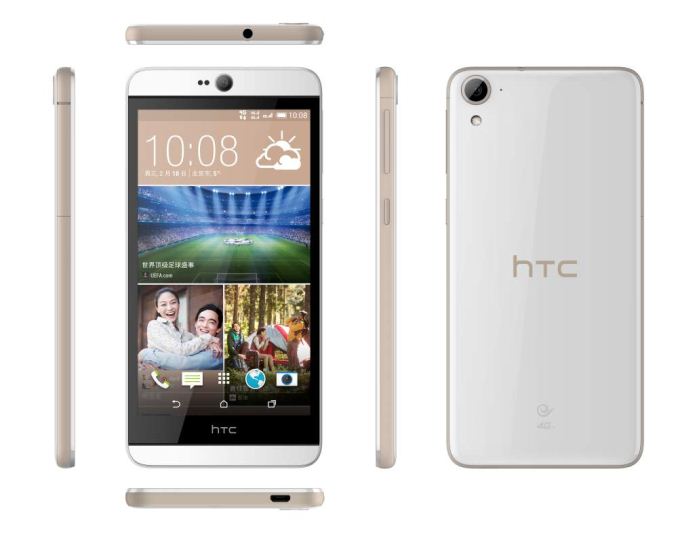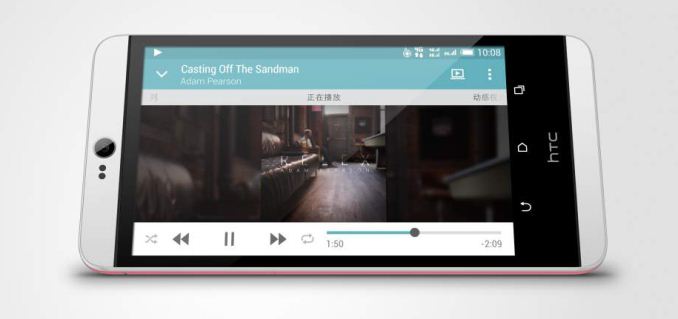HTC Announces the Desire 826
by Brandon Chester on January 6, 2015 4:17 PM EST- Posted in
- Smartphones
- HTC
- CES 2015
- Desire 826

Yesterday at CES, HTC announced the newest device in their lineup of Desire smartphones. Years ago, HTC's flagship devices fell under the Desire brand. In recent years, the Desire brand has been shifted to more budget oriented devices. This new HTC smartphone is the Desire 826, and it follows in the footsteps of the Desire 816 and Desire 820 that came before it. Although it isn't HTC's flagship smartphone, it still has respectable specifications, and in many ways is not far off from today's flagship devices. I've laid out the key specifications of the Desire 826 below.
| HTC Desire 826 | ||||||
| SoC | Qualcomm Snapdragon 615, 4 x Cortex A53 at 1.7GHz + 4 x Cortex A53 at 1.0GHz, Adreno 405 GPU |
|||||
| Memory and Storage | 16GB NAND + MicroSDXC, 2GB LPDDR3 | |||||
| Display | 5.5” 1920x1080 LCD | |||||
| Cellular Connectivity | 2G / 3G / 4G LTE (Qualcomm MDM9x25 UE Category 4 LTE) | |||||
| Dimensions | 158 x 77.5 x 7.99 mm, 183g | |||||
| Camera | 13 MP f/2.2 Rear Facing, 4MP UltraPixel f/2.0 Front Facing or 13MP f/2.0 Front Facing | |||||
| Battery | 2600 mAh (9.88 Whr) | |||||
| Other Connectivity | 802.11 a/b/g/n + BT 4.1, AptX, USB2.0, GPS/GNSS, NFC (in select regions) | |||||
| SIM Size | Nano SIM (Dual SIM SKU available) | |||||
| Operating System | Android 5.0 Lollipop with HTC Sense | |||||
The Desire 826 has a lot in common with the Desire 820 that was released in September 2014. Both devices use Qualcomm's Snapdragon 615 with 2GB of LPDDR3 memory, 16GB of NAND, and 2600mAh (9.88Wh) battery. However, the Desire 826 has a maximum clock speed of 1.7GHz on its high-power A53 cluster, while the Desire 820 was limited to 1.5GHz. Being an Android 5.0 Lollipop device, the Desire 826 will also be 64-bit enabled out of the gate, while the Desire 820 had to operate in 32-bit mode due to a 64-bit version of Android being unavailable. I still believe having two clusters of Cortex-A53s is silly, but HTC weren't the ones making that decision so it's not something I can really fault the phone itself for.
There are some other notable improvements over the Desire 820. The Desire 826 has a significantly sharper display due to HTC's move from 1280x720 to 1920x1080 on the same panel size. The front-facing camera is the other significant difference between the two devices. While the Desire 820 used an 8MP front-facing sensor, the Desire 826 uses a 4MP UltraPixel sensor with an f/2.0 aperture for the front-facing camera in most markets. This should significantly improve low-light camera performance. In certain unspecified markets, the Desire 826 will use a 13MP f/2.0 sensor instead. Like all of HTC's recent devices, the Desire 826 ships with HTC's Eye Experience software for the camera.
The Desire 826 will be available in the Asia-Pacific region by the end of this month, and will expand to other markets afterward. It comes in multiple colors, including but not limited to white, purple, and blue. There is currently no word on what to expect for pricing, but it should be similar to the launch price of the Desire 820.
Source: HTC











40 Comments
View All Comments
PeterCollier - Tuesday, January 6, 2015 - link
So that nexus 9 review ... did Anand make a new years resolution to actually review stuff in a timely manner?Stuka87 - Tuesday, January 6, 2015 - link
You do know Anand has not worked for the site for many months now right? And its owned by a different company?LemmyB - Tuesday, January 6, 2015 - link
They're probably still busy reviewing the Nexus 10. I'm sure it'll be right after :-)tuxRoller - Saturday, January 10, 2015 - link
I believe it was Josh Ho who responded to me a month or so ago and said that it's still coming.My hope is that is still the case, but if they decide to not review it I doubt that they'll announce a non-review:)
Someguyperson - Tuesday, January 6, 2015 - link
Having 8 A53 cores in a smartphone is a complete waste, but that's what the Asia-Pacific region wants, so that's what the Asia-Pacific region gets.Flunk - Tuesday, January 6, 2015 - link
It's not a complete waste, it does use more power than a 4-core A53 chip!saratoga4 - Tuesday, January 6, 2015 - link
Actually it should be more power efficient than a typical 4 core A53 chip, since you have the lower power optimized cluster too.Stuka87 - Tuesday, January 6, 2015 - link
The purpose is to have the faster cores shut down when not in use, to save power by running off the slower chips. Then when demand is high, kick in the higher power chips.But since very few things are very multi-threaded, it is still kind of a waste. Since fast dual core chips keep up in most cases.
kpkp - Tuesday, January 6, 2015 - link
The cores are the same, can't you just scale the V/frequency, it sounds more efficient then migrating processes.MrSpadge - Tuesday, January 6, 2015 - link
The two core clusters will have transistors tuned for different power & performance targets. Up to 1 Ghz the slow ones are more power efficient, whereas the higher frequencies can only be reached by the fast ones. Not sure how much power this actually saves, but Qualcomm has made quite a few simulations before creating such a chip.